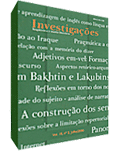O ENUNCIADO “EU NÃO TENHO MEDO DA MUDANÇA” E SUA RELAÇÃO COM A MEMÓRIA DO DIZER
Abstract
Apresentamos um exercício de leitura do enunciado EU NÃO TENHO MEDO DA MUDANÇA, proferido pela atriz Carmem Silva, em outubro/2004 e veiculado no horário eleitoral gratuito, segundo turno da campanha para prefeito de Porto Alegre. No texto, sob a ótica da análise do discurso, articulamos as noções de língua, de leitura e de interpretação. A primeira é base para que o discurso ocorra e pressupõe um sujeito que enuncia afetado pelo inconsciente e pela ideologia. A leitura é entendida como um processo de produção de sentido e, a interpretação, como gesto que remete à memória do dizer.References
COURTINE, Jean Jacques. 1981. Quelques problèmes theoriques et
methodologiques en analyse du discours; à propos du discours communiste adressé aux chrétiens. Langages (62), juin.
COURTINE, Jean Jacques e MARANDIN, Jean Marie. Quel objet pour l'analyse de discours? In: Matérialités Discursives. Actes du Colloque, avril, 1980. Paris X - Nanterre Lille. Presses universitaires de Lille, 1981.
FOUCAULT, Michel. 1972. Arqueologia do Saber. Tradução de Luiz Felipe
Baeta Neves. Petrópolis: Vozes.
INDURSKY, Freda. 1997. A fala dos quartéis e as outras vozes. Tese de
Doutoramento, Campinas, 1992, publicada pela Editora da UNICAMP.
______. 1998. O sujeito e as feridas narcísicas dos lingüistas. In: Gragoatá, n. 5. Niterói, RJ: EdUFF, 2º sem.
______. 2001. Da heterogeneidade do discurso à heterogeneidade do texto e suas implicações no processo da leitura. In: ERNST-PEREIRA, Aracy; FUNCK, Susana Bornéo (orgs.). A leitura e a escrita como práticas discursivas. Pelotas: Educat.
LEANDRO FERREIRA, Maria Cristina. 2000. Da ambigüidade ao equívoco: a resistência da língua nos limites da sintaxe e do discurso. Porto Alegre: Editora da UFRGS.
ORLANDI, Eni Pulcinelli. 1987. A linguagem e o seu funcionamento. Campinas: Pontes.
______. 1993. As formas do silêncio: no movimento dos sentidos. 2. ed.,
Campinas: UNICAMP.
______. 1996. Interpretação; autoria, leitura e efeitos do trabalho simbólico. Petrópolis: Vozes.
______. 1999. Análise de discurso: princípios e procedimentos. Campinas: Pontes.
______. 2001. Discurso e Texto: formulação e circulação dos sentidos.
Campinas: Pontes.
PÊCHEUX, Michel. Semântica e Discurso (1975). Tradução de Eni Pulcinelli Orlandi...[et.al.].Campinas, SP: Ed. da UNICAMP, 1988.
______. 1990a. A análise do Discurso: três épocas. Tradução de Jonas de A. Romualdo. In: GADET & HAK (org). Por uma análise automática do discurso. Campinas: UNICAMP.
______. 1990b. O discurso: estrutura ou acontecimento? Tradução de Eni Pulcinelli Orlandi. Campinas: Pontes.
______. 1999. Papel da memória. Tradução de José Horta Nunes. In:
ACHARD, Pierre...[et al]. Papel da Memória. Campinas: Pontes.
RODRIGUEZ, Carolina. 1998. Sentido, interpretação e história. In: ORLANDI, Eni P. (org.). A leitura e os leitores. Campinas: Pontes.
SAUSSURE, Ferdinand de. 1988. Curso de Lingüística Geral. 14. ed. São
Paulo: Cultrix.
SERRANI, Silvana M. 1993. A linguagem na pesquisa sociocultural: um estudo da repetição na discursividade. Campinas: UNICAMP.
Downloads
Published
How to Cite
Issue
Section
License
Copyright (c) 2005 Ercília Ana Cazarin

This work is licensed under a Creative Commons Attribution 4.0 International License.
Authors who publish with Revista Investigações agree to the following terms:
Authors retain copyright and grant the journal right of first publication with the work simultaneously licensed under the Creative Commons Attribution 4.0 International (CC BY 4.0) license that allows others to share the work with an acknowledgement of the work's authorship and initial publication in this journal.
Authors are able to enter into separate, additional contractual arrangements for the non-exclusive distribution of the journal's published version of the work (e.g., post it to an institutional repository or publish it in a book), with an acknowledgement of its initial publication in this journal.
You are free to:
Share — copy and redistribute the material in any medium or format for any purpose, even commercially.
Adapt — remix, transform, and build upon the material for any purpose, even commercially.
The licensor cannot revoke these freedoms as long as you follow the license terms.
Under the following terms:
Attribution — You must give appropriate credit , provide a link to the license, and indicate if changes were made . You may do so in any reasonable manner, but not in any way that suggests the licensor endorses you or your use.
No additional restrictions — You may not apply legal terms or technological measures that legally restrict others from doing anything the license permits.

